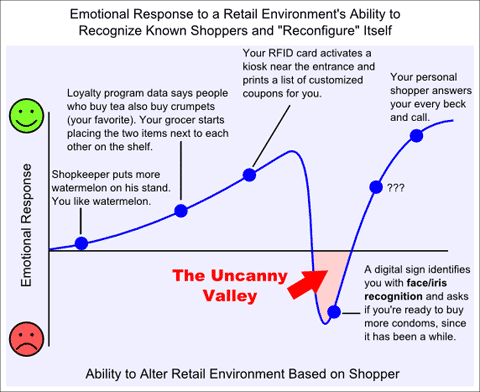What have we learned so far?
On the surface, it might be hard to understand why more retailers haven't jumped on the video tracking bandwagon. After all, virtually every retail chain already uses video surveillance to improve security and loss prevention. Yet retailers, once eager to start tracking, mining and catering to shoppers using video recognition, have remained wary of potentially violating their customers' privacy and thus encouraging them to shop elsewhere. We had some fun with this concept back in 2009, when we looked at whether digital signage is invading people's privacy. In that article, we illustrated how retailers risk falling into the "uncanny valley" by knowing too much about every shopper's habits and buying preferences. I think the graphic we made 3 years ago still illustrates the concept perfectly today:

How should out-of-home venues protect consumer privacy?
Many retailers have been hesitant to implement in-store tracking systems, probably due to concerns about scaring away their customers or opening themselves up to legal action by individuals or privacy advocacy groups. However, several organizations have come forward with suggestions of how to mitigate potential risks to consumer privacy, while still allowing marketers to collect and use data. POPAI's Code of Conduct was one of the first, though others like the Center for Democracy and Technology and the Digital Signage Federation have proffered similar guidelines since then. The long and short of it is, if you plan to collect, store, process or use any kind of surveillance-like data gathering (especially with technology that can uniquely or individually identify consumers, which we'll cover in a minute), then you really ought to:
- Disclose data collection methods: Put up signs, make pamphlets available, put up a web page. I know that this will be anathema to retailers, but a consumer's expectation -- which is mirrored by the FTC's own recommendations to related industries -- is that the more potentially privacy-invading the tracking technique, the more good you can do by plainly disclosing it ahead of time.
- Get customer consent to be monitored: This isn't going to be practical in all cases, but again, giving people a modicum of power inside your venue translates to an improved sense of trust and a stronger customer relationship.
- Know the difference between unique and individual identification: In short, unique identification means that you can track an individual apart from other individuals as they travel through the venue. Individual identification means that you can take that tracking data and correlate it to a specific person, either via some personal information like a name or address, or via an account number.
- Allow customers to opt in (or opt out) of more intrusive monitoring practices: Like getting consent, this probably isn't going to be practical or even possible in many cases. But the opt-in (and even more so, the opt-out) is the thing that will hopefully keep this type of tracking out of the hands of regulators.
- Practice cross-channel and cross-domain marketing constraints. Imagine a scenario where a cross-retailer loyalty program can track an individual as he goes from the supermarket to the dry cleaner to an apparel store to a big-box retailer. Such a system would clearly be able to collect a vast amount of personal information. Just as the FTC is currently trying to limit the ability of Internet marketers to track consumer behavior over a large variety of Internet properties, they will likely try to do the same thing in the real world at the first sign of trouble.
My gut feeling is that for most people, the answer is still "No." As I mentioned in the TIME article, people are used to being tracked 24/7 by all of the services running on their smartphones. For many of these people, it probably seems completely normal that retailers and others would use that data or take measures to collect even more data. From my personal perspective, though, the thought of involuntarily losing even more privacy is unnerving. After all, turning off my cellphone and not using apps that constantly track my whereabouts is pretty easy. Having to switch supermarkets or something similar would be much more inconvenient. But it's certainly possible that my opinion is the exception rather than the rule. Maybe I'm too close to the issue, and as such am unable to deviate from the course I've been pursuing all this time. Maybe I have too much unjustified mistrust of those who are collecting, collating and using all of this data. Or maybe at the ripe old age of 34, I'm just too out of touch with the mindset of today's younger consumers to understand what's important.
That said, TIME is currently running a poll to ask readers what they think. Surprisingly, a glance at the early survey results showed that nearly 40% of respondents agree that certain kinds of tracking do cross the line, and would be considered intrusive invasions of privacy sufficient to force the shopper to change his behavior and shop elsewhere. While I'm sure the adverse selection effect is in play (i.e. people interested in privacy are more likely to read the article and fill out the survey), it's still encouraging to think that the notion of privacy might not be completely dead yet.
Is in-store privacy something to worry about, or am I just being paranoid? Leave a comment and let me know!

 Subscribe to the Digital Signage Insider RSS feed
Subscribe to the Digital Signage Insider RSS feed
Comments
RSS feed for comments to this post